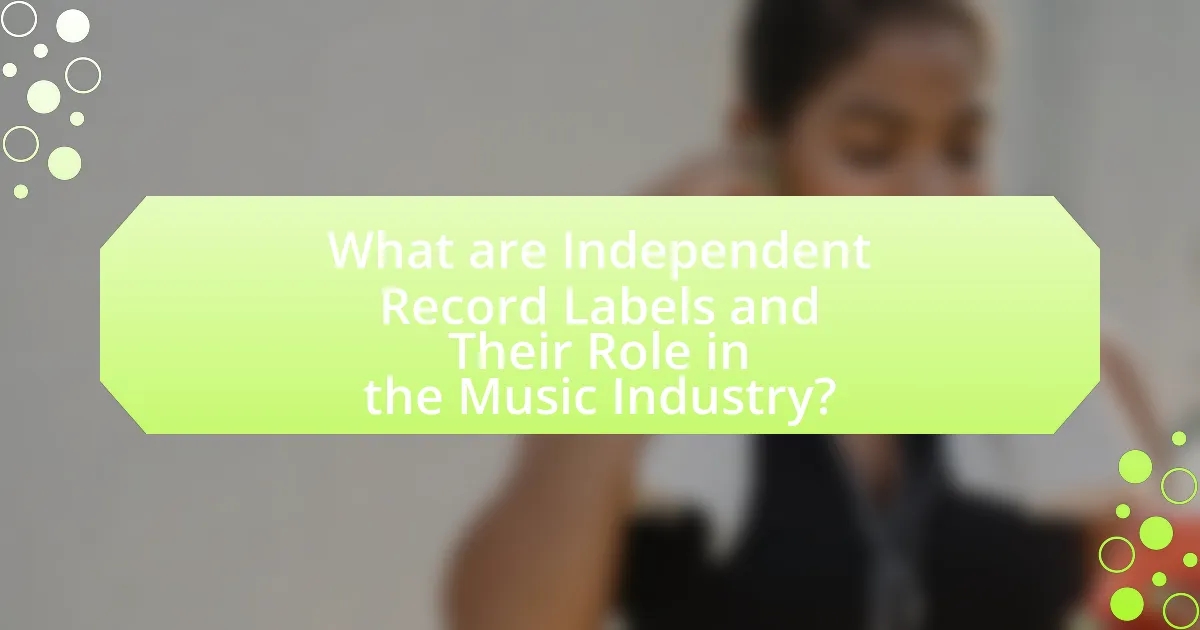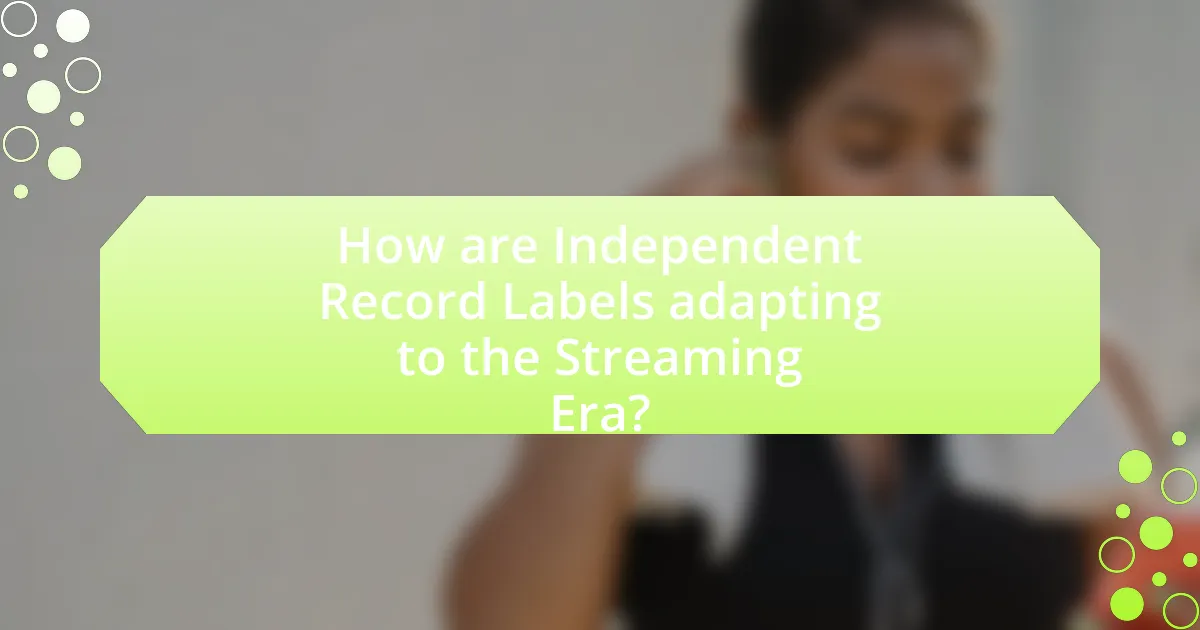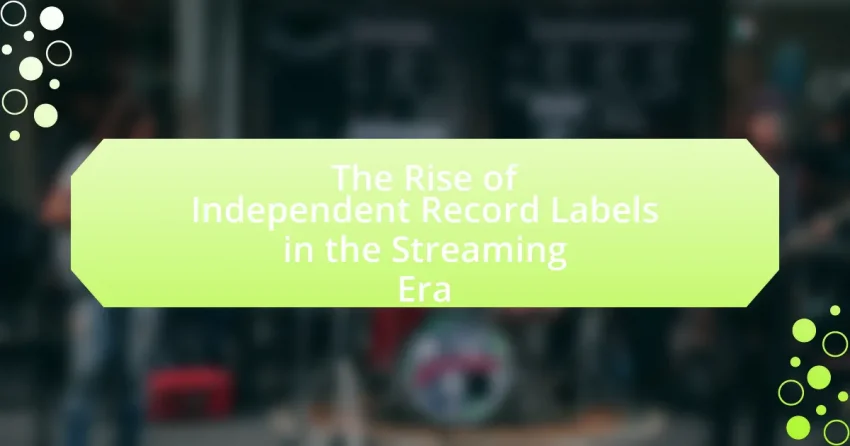Independent record labels are music companies that operate without major label backing, allowing for greater creative control and a focus on niche markets. This article explores the significant role independent labels play in the music industry, including their impact on artist discovery, genre diversity, and innovation in music distribution, particularly in the streaming era. It examines the differences between independent and major labels, the financial implications of streaming, the challenges faced by independent labels, and the strategies they employ to thrive in a competitive landscape. Additionally, the article discusses the future prospects for independent labels as they adapt to evolving market dynamics and leverage technology for growth.

What are Independent Record Labels and Their Role in the Music Industry?
Independent record labels are music companies that operate without the financial backing of major record labels, allowing them to maintain creative control and focus on niche markets. Their role in the music industry includes discovering and promoting emerging artists, providing a platform for diverse musical genres, and fostering innovation in music production and distribution. According to a report by the International Federation of the Phonographic Industry (IFPI), independent labels accounted for 40% of global recorded music revenue in 2020, highlighting their significant impact on the industry. This growth is largely attributed to the rise of digital streaming platforms, which have enabled independent artists to reach wider audiences without traditional gatekeepers.
How do Independent Record Labels differ from Major Labels?
Independent record labels differ from major labels primarily in their operational scale and artist relationships. Independent labels typically have smaller budgets, allowing for more creative freedom and personalized attention to artists, while major labels often have extensive resources and marketing power but may impose more commercial constraints on their artists. For instance, independent labels can prioritize niche genres and unique artistic visions, whereas major labels focus on mainstream appeal and profitability, as evidenced by the fact that independent labels accounted for 40% of global music sales in 2020, according to the International Federation of the Phonographic Industry. This distinction highlights the contrasting approaches to artist development and market strategy between the two types of labels.
What are the key characteristics of Independent Record Labels?
Independent record labels are characterized by their autonomy from major record companies, allowing for greater creative control and flexibility in artist development. These labels typically prioritize niche markets and often focus on specific genres or local talent, enabling them to cultivate unique sounds and foster close relationships with their artists. Additionally, independent record labels usually operate with lower budgets, which encourages innovative marketing strategies and direct engagement with fans through social media and live events. According to a 2021 report by the International Federation of the Phonographic Industry, independent labels accounted for 40% of global recorded music revenue, highlighting their significant impact in the industry.
Why do artists choose Independent Labels over Major Labels?
Artists choose independent labels over major labels primarily for greater creative control and a more personalized approach to their music careers. Independent labels typically offer artists the freedom to make artistic decisions without the constraints often imposed by major labels, which may prioritize commercial viability over artistic expression. Additionally, independent labels often provide better revenue splits, allowing artists to retain a larger percentage of their earnings. For instance, a study by the Future of Music Coalition found that independent artists can earn up to 70% of their revenue compared to the 10-20% typically offered by major labels. This financial incentive, combined with the desire for artistic autonomy, drives many artists to prefer independent labels.
What impact has the Streaming Era had on Independent Record Labels?
The Streaming Era has significantly increased the visibility and revenue potential for Independent Record Labels. With platforms like Spotify and Apple Music, independent artists can distribute their music globally without the need for major label backing, allowing labels to reach wider audiences. According to a report by the International Federation of the Phonographic Industry (IFPI), independent labels accounted for 40% of global recorded music revenue in 2020, demonstrating their growing influence in the market. This shift has enabled independent labels to thrive by leveraging digital marketing and social media, further enhancing their ability to connect with fans directly.
How has streaming changed the way music is distributed?
Streaming has fundamentally transformed music distribution by enabling artists to release their work directly to consumers without traditional intermediaries like record labels. This shift has allowed independent artists to reach global audiences instantly, as platforms like Spotify and Apple Music provide access to millions of listeners. According to the Recording Industry Association of America (RIAA), streaming accounted for 83% of the U.S. music industry’s revenue in 2020, illustrating its dominance over physical sales and downloads. This change has democratized music distribution, allowing independent labels to thrive by leveraging streaming services for marketing and distribution, thus reshaping the entire music industry landscape.
What are the financial implications of streaming for Independent Labels?
Streaming has significant financial implications for independent labels, primarily affecting revenue generation and market reach. Independent labels often receive lower per-stream payouts compared to major labels, which can limit their income from streaming platforms. For instance, the average payout per stream is estimated to be between $0.003 and $0.005, making it challenging for independent labels to sustain profitability without a substantial volume of streams.
Moreover, streaming allows independent labels to reach global audiences without the need for traditional distribution channels, potentially increasing their market share. According to a report by the International Federation of the Phonographic Industry (IFPI), independent labels accounted for 32% of global recorded music revenue in 2020, highlighting the growing importance of streaming in their financial ecosystem.
However, the reliance on streaming also means that independent labels must invest in marketing and promotion to drive streams, which can strain their limited budgets. The financial landscape for independent labels in the streaming era is thus characterized by both opportunities for wider exposure and challenges related to revenue sustainability.
What challenges do Independent Record Labels face in the Streaming Era?
Independent record labels face significant challenges in the streaming era, primarily due to reduced revenue from music sales and increased competition. The shift to streaming has led to a decline in physical and digital album sales, with independent labels often receiving a smaller share of streaming royalties compared to major labels. For instance, according to a 2021 report by the International Federation of the Phonographic Industry, independent labels earned only 30% of the total streaming revenue, while major labels dominated the market. Additionally, independent labels struggle with marketing and visibility in a crowded digital landscape, where algorithms favor established artists, making it difficult for new or lesser-known acts to gain traction. This combination of financial constraints and visibility issues poses a significant barrier to the growth and sustainability of independent record labels in the streaming era.
How do Independent Labels compete with Major Labels in a streaming-dominated market?
Independent labels compete with major labels in a streaming-dominated market by leveraging niche marketing, direct artist relationships, and innovative distribution strategies. These labels often focus on specific genres or communities, allowing them to build dedicated fan bases that major labels may overlook. For instance, independent labels like Sub Pop and XL Recordings have successfully cultivated unique identities and loyal audiences, which enhances their visibility on streaming platforms.
Additionally, independent labels frequently offer artists more favorable contract terms, retaining a larger share of revenue, which can be appealing in a market where streaming payouts are low. According to a 2021 report by the International Federation of the Phonographic Industry (IFPI), independent labels accounted for 32% of global recorded music revenue, demonstrating their growing influence and ability to compete effectively against major labels. This competitive edge is further supported by the rise of social media and digital marketing, enabling independent labels to promote their artists directly to consumers without the need for extensive resources typically available to major labels.
What are the common obstacles Independent Labels encounter with streaming platforms?
Independent labels commonly encounter obstacles such as limited visibility, lower revenue shares, and challenges in data access on streaming platforms. Limited visibility arises because major labels often dominate playlists and promotional opportunities, making it difficult for independent artists to gain exposure. Lower revenue shares are a significant issue, as streaming platforms typically offer smaller payouts per stream, which disproportionately affects independent labels that rely on these earnings. Additionally, challenges in data access hinder independent labels from effectively analyzing listener trends and making informed marketing decisions, as they often receive less comprehensive analytics compared to major labels. These factors collectively impede the growth and sustainability of independent labels in the streaming era.

How are Independent Record Labels adapting to the Streaming Era?
Independent record labels are adapting to the streaming era by leveraging digital platforms for distribution and marketing, allowing them to reach wider audiences without the need for traditional distribution channels. These labels are utilizing social media and streaming services like Spotify and Apple Music to promote their artists, often focusing on niche markets that larger labels may overlook. For instance, according to a 2021 report by the International Federation of the Phonographic Industry (IFPI), independent labels accounted for 32% of global recorded music revenue, highlighting their growing influence in the streaming landscape. Additionally, many independent labels are embracing data analytics to understand listener preferences and optimize their marketing strategies, further enhancing their ability to compete in a rapidly evolving industry.
What innovative strategies are Independent Labels using to thrive?
Independent labels are thriving by leveraging digital marketing, direct-to-fan sales, and strategic partnerships. These labels utilize social media platforms to engage audiences and promote their artists, which allows them to build a loyal fan base without the need for traditional marketing budgets. For instance, independent labels often sell music directly through platforms like Bandcamp, which enables them to retain a larger share of revenue compared to traditional distribution methods. Additionally, collaborations with other independent artists and labels create synergies that enhance visibility and reach. According to a report by MIDiA Research, independent labels accounted for 30% of global recorded music revenues in 2021, demonstrating their growing influence and effectiveness in the streaming era.
How are Independent Labels leveraging social media for promotion?
Independent labels are leveraging social media for promotion by utilizing platforms like Instagram, TikTok, and Twitter to engage directly with audiences and build a community around their artists. These labels create targeted content, such as behind-the-scenes videos, live Q&A sessions, and interactive posts, which foster a personal connection with fans. For instance, a study by MIDiA Research in 2021 found that independent labels that actively engage on social media see a 30% increase in fan interaction compared to those that do not. This strategy not only enhances visibility but also drives streaming numbers and concert attendance, demonstrating the effectiveness of social media in promoting independent music.
What role does artist collaboration play in the success of Independent Labels?
Artist collaboration significantly enhances the success of independent labels by expanding their reach and diversifying their sound. Collaborations allow independent artists to tap into each other’s fan bases, increasing visibility and engagement. For instance, a study by the Berklee College of Music found that collaborative projects often lead to higher streaming numbers and social media interactions, which are crucial metrics in the streaming era. Additionally, collaborations can result in innovative music that attracts attention from both listeners and industry professionals, further solidifying the label’s reputation and market presence.
How do Independent Record Labels build their brand in the Streaming Era?
Independent record labels build their brand in the streaming era by leveraging digital platforms, engaging directly with audiences, and focusing on niche markets. These labels utilize streaming services like Spotify and Apple Music to distribute music widely, allowing them to reach global audiences without the need for traditional distribution channels. For instance, independent labels often create curated playlists that feature their artists, enhancing visibility and engagement.
Additionally, they engage with fans through social media platforms, fostering a community around their brand and artists. This direct interaction helps build loyalty and encourages word-of-mouth promotion. According to a 2021 report by MIDiA Research, independent labels accounted for 40% of global music consumption, highlighting their growing influence and ability to connect with listeners effectively.
Furthermore, independent labels often focus on specific genres or themes, allowing them to carve out a unique identity in a crowded market. This specialization not only attracts dedicated fan bases but also enhances their brand recognition in the streaming landscape.
What branding techniques are effective for Independent Labels?
Effective branding techniques for independent labels include creating a strong visual identity, leveraging social media for direct engagement, and building a community around the music. A strong visual identity, such as a unique logo and cohesive artwork, helps differentiate the label in a crowded market. Social media platforms like Instagram and TikTok allow independent labels to connect directly with fans, share behind-the-scenes content, and promote new releases, which is crucial in the streaming era where personal connection drives engagement. Additionally, fostering a community through events, collaborations, and fan interactions enhances loyalty and word-of-mouth promotion, which are vital for independent labels competing against major labels. These techniques are supported by the fact that independent labels often rely on grassroots marketing strategies, as evidenced by the success of artists who have built substantial followings through authentic engagement rather than traditional advertising.
How important is audience engagement for Independent Labels?
Audience engagement is crucial for independent labels as it directly influences their visibility and success in a competitive market. Independent labels often lack the marketing budgets of major labels, making strong audience engagement essential for building a loyal fan base and driving sales. According to a 2021 report by MIDiA Research, independent labels that actively engage with their audience through social media and live events see a 30% increase in fan retention compared to those that do not. This engagement fosters community, enhances brand loyalty, and ultimately leads to increased streaming numbers and merchandise sales, proving that audience interaction is a key factor in the sustainability and growth of independent labels in the streaming era.

What are the future prospects for Independent Record Labels in the Streaming Era?
Independent record labels are poised for growth in the streaming era due to their ability to adapt to changing market dynamics and leverage digital platforms. The rise of streaming services has democratized music distribution, allowing independent labels to reach global audiences without the need for traditional distribution channels. According to the Recording Industry Association of America (RIAA), independent labels accounted for 36% of the U.S. music market share in 2022, reflecting their increasing influence. Additionally, independent labels often foster niche genres and artist development, which can lead to dedicated fan bases and higher engagement on streaming platforms. This adaptability, combined with innovative marketing strategies and direct-to-consumer sales, positions independent record labels favorably for future success in the evolving music landscape.
How is the landscape of the music industry expected to evolve?
The landscape of the music industry is expected to evolve towards increased prominence of independent record labels, driven by the growth of streaming platforms. Independent labels are gaining market share, with statistics showing that they accounted for 40% of global recorded music revenue in 2022, up from 30% in 2019. This shift is largely due to the accessibility of digital distribution and social media marketing, which allow independent artists to reach audiences without the need for major label support. Additionally, consumer preferences are shifting towards diverse and niche music offerings, further benefiting independent labels that cater to specific genres and communities.
What trends are emerging that could benefit Independent Labels?
Emerging trends that could benefit independent labels include the rise of direct-to-fan platforms and the increasing importance of social media for music promotion. Direct-to-fan platforms, such as Bandcamp and Patreon, allow independent artists to sell their music and merchandise directly to consumers, bypassing traditional distribution channels and retaining a larger share of revenue. Additionally, social media platforms like TikTok and Instagram enable independent labels to reach wider audiences through viral marketing and user-generated content, fostering organic growth and engagement. According to a 2022 report by MIDiA Research, independent labels accounted for 40% of global music revenue, highlighting their growing influence in the industry.
How might technology continue to shape the future of Independent Labels?
Technology will continue to shape the future of independent labels by enhancing their distribution capabilities and marketing strategies. Digital platforms like Spotify and Bandcamp allow independent labels to reach global audiences without the need for traditional distribution channels, which historically favored major labels. Additionally, advancements in data analytics enable independent labels to better understand listener preferences and tailor their marketing efforts accordingly. For instance, a report by MIDiA Research indicates that independent labels accounted for 40% of global recorded music revenue in 2021, showcasing their growing influence facilitated by technology. This trend is expected to persist as tools for music production, promotion, and audience engagement become increasingly accessible and sophisticated.
What practical tips can Independent Record Labels implement for success?
Independent record labels can implement several practical tips for success, including leveraging digital marketing strategies, building strong artist relationships, and diversifying revenue streams. Digital marketing strategies, such as utilizing social media platforms and targeted online advertising, can enhance visibility and engagement with potential listeners. Strong artist relationships foster loyalty and collaboration, which can lead to innovative projects and increased fan engagement. Diversifying revenue streams, such as through merchandise sales, live performances, and licensing deals, can provide financial stability and reduce reliance on streaming income, which has been shown to be less lucrative for independent labels compared to major labels. According to a report by the International Federation of the Phonographic Industry, independent labels accounted for 32% of global recorded music revenue in 2020, highlighting their growing significance in the industry.
How can Independent Labels effectively utilize data analytics?
Independent labels can effectively utilize data analytics by leveraging streaming data to understand listener preferences and optimize marketing strategies. By analyzing metrics such as play counts, demographic information, and engagement rates, independent labels can identify trends and target specific audiences more accurately. For instance, a report from MIDiA Research indicates that independent labels that utilize data analytics can increase their market share by up to 30% by tailoring their promotional efforts based on listener insights. This data-driven approach allows independent labels to make informed decisions regarding artist development, release strategies, and tour planning, ultimately enhancing their competitive edge in the streaming era.
What best practices should Independent Labels follow for artist development?
Independent labels should prioritize personalized artist development strategies that focus on building a strong brand identity and fostering direct fan engagement. This approach includes creating tailored marketing plans that leverage social media platforms, as 90% of music consumers engage with artists online, according to a 2021 Nielsen report. Additionally, independent labels should invest in professional development opportunities for artists, such as songwriting workshops and performance coaching, which can enhance their skills and marketability. Collaborating with industry professionals for mentorship can also provide valuable insights and networking opportunities, further supporting an artist’s growth. By implementing these best practices, independent labels can effectively nurture talent and adapt to the evolving landscape of the music industry.
